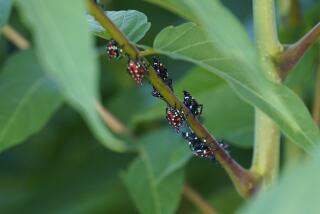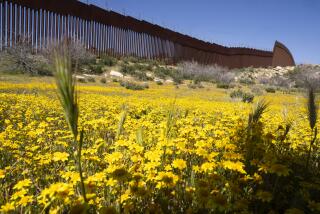Reaching new heights
Thirty-three years after being classified an endangered species, the El Segundo blue butterfly is flourishing on 200 acres of sand dunes near Los Angeles International Airport.
Entomologist Richard Arnold, a consultant to the airport, said Wednesday that the butterfly population there has grown to 35,000 to 100,000 insects, depending on the year, up from a few thousand when the federal government placed it on the endangered list in 1976.
Arnold took a group of reporters and airport employees on a search for the butterflies at El Segundo dunes, southwest of the north runway, an area off-limits to the public.
They weren’t hard to find, darting through seacliff buckwheat, trading places with bees and cabbage butterflies.
The black, white and orange El Segundo blue -- the male has blue on top of its wings -- stays close to the plant that is so important to its life cycle.
The larvae feed on the seeds inside the plants’ flower head, a collection of tiny flowers that look like a puff of cotton, and the adults suck out the nectar.
The El Segundo blue, with a wingspan the size of a thumbnail, was the third insect classified an endangered species, after two insects in Florida.
There are now about 50 insects on the federal endangered species list, Arnold said.
There is, he said, some wildlife in the dunes that is even rarer than the butterfly.
Until recently, the butterfly was thought to be found only on the southeastern shores of Santa Monica Bay.
But the largest population by far is now found near the airport, with smaller colonies on two acres at Chevron’s El Segundo refinery, on private land in Torrance and, in a migration that has surprised experts, at beaches in Torrance and Redondo Beach.
In the last few years, another group of El Segundo blues has been found at Vandenberg Air Force Base in Santa Barbara County, Arnold said.
Once there were homes on the airport land, but LAX bought them and demolished them in the late 1960s and early ‘70s when the noise from jets became too loud.
“Butterflies don’t seem to mind the noise,” Arnold said as a jet roared above him.
Most of the restoration effort in the dunes has been focused on planting seacliff buckwheat and clearing nonnative weeds and grasses that make it difficult for it to grow.
Although two airport employees work full time at the task, the area is still filled with dry weeds.
The butterfly life cycle is a year, and they live as adults only four to seven days, Arnold said.
In that brief period, females typically mate and lay eggs, more than 99% of which never complete the cycle into adulthood.
The butterfly flight season, when the pupae become adults, runs from mid-June through mid-August.
Arnold said that two weeks ago, at the peak of the season, he counted 4,800 butterflies, which was about 10% more than last year.
The top number was the 7,000 he counted six or seven years ago.
Although he was happy with the way the insect has rebounded, Arnold said more seacliff buckwheat would mean more El Segundo blues.
“I don’t want to create the mistaken impression that nothing needs to be done to benefit the butterfly,” he said.
--
More to Read
Sign up for The Wild
We’ll help you find the best places to hike, bike and run, as well as the perfect silent spots for meditation and yoga.
You may occasionally receive promotional content from the Los Angeles Times.







